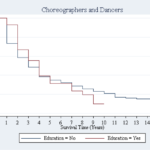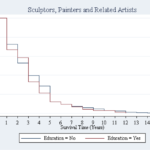By Trine Bille and Søren Jensen
The literature of cultural economics generally finds that an artistic education has no significant impact on artists’ income and careers in the arts. In our research, we have readdressed this question by looking at the artists’ survival in the arts occupations. The results show that an artistic education has a significant impact on artists’ careers in the arts and we find important industry differences.
It is well known that many (young) people have given it a try in the arts and the creative industries, but few are able to make it into a career. Our survival curves (Figure 1) show clearly how vulnerable a career in the arts is. On average, only about 20 per cent of the artists have survived in the occupation after 10 years. Besides, some groups of artists are more vulnerable than others. Actors leave the artistic occupation the fastest, possibly because of the low entry barriers.
Figure 1. Survival curves for five groups of artists

Artistic educations, such as an education from the Academy of Fine Arts, an actor’s education or a music education, may provide artists with important skills. But the literature has shown that artistic education may have little, if any, important impact on artists’ incomes and careers (Towse, 2006). Many artists are self-taught (Alper and Wassall, 2006), and individual artistic talent may be the important driver of a career within the arts. In general, the empirical results of most studies show no or very weak impact of education on artistic earnings, but a positive impact on non-artistic earnings (Alper and Wassall, 2006, Throsby, 1992, 1994, 1996).
Even though most studies show that a formal artistic education has no impact on artists’ earnings in the arts, it seems to be contrary to expectations. Artists, like most people in other occupations, may benefit from education. Among other things, a formal education can provide technical skills and networks, and may have a signaling effect for some artists’ professions. All else being equal, we will therefore expect an artistic education to have a significant positive impact on artists’ careers.
Our study compared different groups of artists, their survival in the artists’ labor market, and the influence of an artistic education. The five groups of artists included in this study are: sculptors, painters and related artists (4,851 individuals); choreographers and dancers (296 individuals); film, stage and related actors and directors (3,813 individuals); composers, musicians and singers (3,161 individuals); and authors, journalists and other writers (14,943 individuals).
We can expect some differences between industries. The importance of technical skills acquired through an artistic education may depend on the particular artistic occupation. We expect technical skills to be more important for musicians, actors and dancers, than for visual artists, for whom formal skills may be less important as an entry barrier and as a driver for success, and the need to develop a personal style may be more important. When it comes to writers, many are journalists. For them, a formal education may be important, both because of the technical skills gained and the signaling effect to the employers; a formal education may serve as a signal of workers’ quality. The impact of networks may be important in all industries.
The survival curves for artists with and without an artistic education show a very strong effect of a formal artistic education, except for visual artists and dancers (Figure 2-6).
For visual artists and dancers an artistic education is not significant for survival as an artist. This may not come as a surprise, as many visual artists are self-taught and able to make a living without an education. Actually, only 2 percent of the visual artists in the dataset have a formal artistic education. For dancers, the result may be explained by the few observations in the sample.
For the other groups of artists, a formal and relevant artistic education seems to have an important impact on their survival in the arts. A relevant artistic education appears to be most important for authors, journalists and writers, as seen in Figure 6. This relates well to expectations; most of these people are journalists, for whom the labor market functions more like an ordinary labor market, and where an education, among other things, may have an important signaling effect to employers. For musicians and especially actors, we can see that a formal artistic education has a huge impact on survival during the first years, but then the impact evens out.
The main contribution of this study is the conclusion that a relevant artistic education has a positive significant impact on staying in the arts professions for three of the five groups of artists; namely, actors, musicians, and writers and journalists. It shows the importance of artistic educations and the skills developed. However, for visual artists and dancers, it cannot be concluded that an artistic education is not important. Even though only very few of the visual artists have a formal artistic education, it can have a big impact in another way, namely in developing the arts. For dancers, the sample is very small, but for instance for ballet dancers, the official ballet school is crucial for a career as a ballet dancer. For other types of dancers it don’t seem to be the case.
Data:
Our analysis is based on national data from Statistics Denmark, which makes it possible to follow all artists during the period 1996-2012, 18 to 70 years of age (excluding pensioners) with a positive income, for whom art is the main activity and income source.
The article is based on:
Trine Bille and Søren Jensen (2016): Artistic education matters: Survival in the arts occupations, Journal of Cultural Economics, Published online 20.6.2016
Other references:
Alper, N. and G.H. Wassall (2006): Artists’ careers and their labor markets. In: V.A. Ginsburgh and D. Throsby (eds): Handbook of the economics of the arts and culture, Elsevier Science, North Holland, Amsterdam, pp 813-864
Throsby, D. (1992): Artists as workers. Reprinted in: R. Towse (eds) (1997): Cultural economics. The arts, the heritage and the media industries, Edward Elgar, Cheltenham
Throsby, D. (1994): A work-preference model of artist behavior. In: A. Peacock and I. Rizzo (eds): Cultural economics and cultural policies, Kluwer Academic Publishers, Dordrecht, pp 69–80
Throsby, D. (1996): Disaggregated earnings functions for artists. In: V. Ginsburgh and P.-M. Menger (eds.): Economics of the Arts: Selected Essays, Kluwer Academic Publishers, Dordrecht, pp 331-346
Towse, R. (2006): Human capital and artists’ labour markets. In: V.A. Ginsburgh and D. Throsby (eds): Handbook of the economics of the arts and culture, Elsevier Science, North-Holland, Amsterdam, pp 865–894
Author information:
Trine Bille is Professor, PhD, at Copenhagen Business School, Department of Management, Politics and Philosophy.
Søren Jensen is academic employee at SFI – the Danish National Centre for Social Research.
Image:
“The Drawing Class” by Michiel Sweerts (1656). Image in Public Domain.












